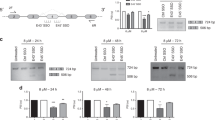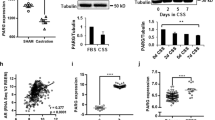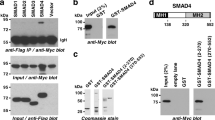Abstract
Transcription factor early growth response-1 (Egr-1) is a crucial regulator of cell growth, differentiation and survival. Several observations suggest that Egr-1 is growth promoting in prostate cancer cells and that blocking its function may impede cancer progression. To test this hypothesis, we developed phosphorothioate antisense oligonucleotides that efficiently inhibit Egr-1 expression without altering the expression of other family members Egr-2, Egr-3 and Egr-4. In TRAMP mouse-derived prostate cancer cell lines, our optimal antisense oligonucleotide decreased the expression of the Egr-1 target gene transforming growth factor-β1 whereas a control oligonucleotide had no effect, indicating that the antisense blocked Egr-1 function as a transcription factor. The antisense oligonucleotide deregulated cell cycle progression and decreased proliferation of the three TRAMP cell lines by an average of 54±3%. Both colony formation and growth in soft agar were inhibited by the antisense oligonucleotide. When TRAMP mice were treated systemically for 10 weeks, the incidence of palpable tumors at 32 weeks of age in untreated mice or mice injected with the control scramble oligonucleotide was 87%, whereas incidence of tumors in antisense-Egr-1-treated mice was significantly reduced to 37% (P=0.026). Thus, Egr-1 plays a functional role in the transformed phenotype and may represent a valid target for prostate cancer therapy.
This is a preview of subscription content, access via your institution
Access options
Subscribe to this journal
Receive 50 print issues and online access
$259.00 per year
only $5.18 per issue
Buy this article
- Purchase on Springer Link
- Instant access to full article PDF
Prices may be subject to local taxes which are calculated during checkout







Similar content being viewed by others
Abbreviations
- Egr-1:
-
early growth response-1
- TGF:
-
transforming growth factor
- NAB:
-
nerve growth factor-I A binding protein
- PTEN:
-
phosphatase and TENsin homolog deleted on chromosome 10
- GAPDH:
-
glyceraldehyde-3-phosphate dehydrogenase
- SDS:
-
sodium dodecyl sulfate
- RT–PCR:
-
reverse transcription–polymerase chain reaction
- TPA:
-
12-O-tetradecanoylphorbol-13-acetate
- s.e.:
-
standard error
References
Abdulkadir SA, Carbone JM, Naughton CK, Humphrey PA, Catalona WJ and Milbrandt J . (2001a). Hum. Pathol., 32, 935–939.
Abdulkadir SA, Qu Z, Garabedian E, Song SK, Peters TJ, Svaren J, Carbone JM, Naughton CK, Catalona WJ, Ackerman JJ, Gordon JI, Humphrey PA and Milbrandt J . (2001b). Nat. Med., 7, 101–107.
Adamson ED and Mercola D . (2002). Tumor Biol., 23, 93–102.
Ahmed MM, Venkatasubbarao K, Fruitwala SM, Muthukkumar S, Wood Jr DP, Sells SF, Mohiuddin M and Rangnekar VM . (1996). J. Biol. Chem., 271, 29231–29237.
Arai M, Yoguchi A, Takizawa T, Yokoyama T, Kanda T, Kurabayashi M and Nagai R . (2000). Circ. Res., 86, 8–14.
Berube NG, Speevak MD and Chevrette M . (1994). Cancer Res., 54, 3077–3081.
Bost F, McKay R, Dean NM, Potapova O and Mercola D . (2000). Methods Enzymol., 314, 342–362.
Christy BA, Lau LF and Nathans DA . (1988). Proc. Natl. Acad. Sci. USA, 85, 7857–7861.
Cogswell PC, Mayo MW and Baldwin Jr AS . (1997). J. Exp. Med., 185, 491–497.
Dey BR, Sukhatme VP, Roberts AB, Sporn MB, Rauscher III FJ and Kim SJ . (1994). Mol. Endocrinol., 8, 595–602.
Eid MA, Kumar MV, Iczkowski KA, Bostwick DG and Tindall DJ . (1998). Cancer Res., 58, 2461–2468.
Foster BA, Gingrich JR, Kwon ED, Madias C and Greenberg NM . (1997). Cancer Res., 57, 3325–3330.
Galderisi U, Cascino A and Giordano A . (1999). J. Cell Physiol., 181, 251–257.
Gashler AL, Swaminathan S and Sukhatme VP . (1993). Mol. Cell. Biol., 13, 4556–4571.
Gousseva N, Kugathasan K, Chesterman CN and Khachigian LM . (2001). J. Cell Biochem., 81, 523–534.
Greenberg NM, DeMayo F, Finegold MJ, Medina D, Tilley WD, Aspinall JO, Cunha GR, Donjacour AA, Matusik RJ and Rosen JM . (1995). Proc. Natl. Acad. Sci. USA, 92, 3439–3443.
Hofer G, Grimmer C, Sukhatme VP, Sterzel RB and Rupprecht HD . (1996). J. Biol. Chem., 271, 28306–28310.
Hu RM and Levin ER . (1994). J. Clin. Invest., 93, 1820–1827.
Huang RP, Liu C, Fan Y, Mercola D and Adamson ED . (1995). Cancer Res., 55, 5054–5062.
Irving SG, June CH, Zipfel PF, Siebenlist U and Kelly K . (1989). Mol. Cell. Biol., 9, 1034–1040.
Jackson MW, Roberts JS, Heckford SE, Ricciardelli C, Stahl J, Choong C, Horsfall DJ and Tilley WD . (2002). Cancer Res., 62, 854–859.
Kinane TB, Finder JD, Kawashima A, Brown D, Abbate M, Shang C, Fredericks WJ, Rauscher III FJ, Sukhatme VP and Ercolani L . (1994). J. Biol. Chem., 269, 27503–27509.
Kroon ME, Koolwijk P, van der Vecht B and van Hinsbergh VW . (2001). J. Cell Sci., 114, 825–833.
Lemaire P, Revelant O, Bravo R and Charnay P . (1988). Proc. Natl. Acad. Sci. USA, 85, 4691–4695.
Lim RW, Varnum BC and Herschman HR . (1987). Oncogene, 1, 263–270.
Liu C, Adamson ED and Mercola D . (1996). Proc. Natl. Acad. Sci. USA, 93, 11831–11836.
Liu C, Rangnekar VM, Adamson E and Mercola D . (1998). Cancer Gene Ther., 5, 3–28.
McMenamin ME, Soung P, Perera S, Kaplan I, Loda M and Sellers WR . (1999). Cancer Res., 59, 4291–4296.
Milbrandt J . (1987). Science, 238, 797–799.
Molnar G, Crozat A and Pardee AB . (1994). Mol. Cell. Biol., 14, 5242–5248.
Muthukkumar S, Han SS, Rangnekar VM and Bondada S . (1997). J. Biol. Chem., 272, 27987–27993.
Muthukkumar S, Nair P, Sells SF, Maddiwar NG, Jacob RJ and Rangnekar VM . (1995). Mol. Cell. Biol., 15, 6262–6272.
Nguyen HQ, Hoffman-Liebermann B and Liebermann DA . (1993). Cell, 72, 197–209.
Nishi H, Nishi KH and Johnson AC . (2002). Cancer Res., 62, 827–834.
O'Donovan KJ, Tourtellotte WG, Milbrandt J and Baraban JM . (1999). Trends Neurosci., 22, 167–173.
Okada M, Fujita T, Sakaguchi T, Olson KE, Collins T, Stern DM, Yan SF and Pinsky DJ . (2001). FASEB J., 15, 2757–2759.
Perez-Castillo A, Pipaon C, Garcia I and Alemany S . (1993). J. Biol. Chem., 268, 19445–19450.
Russell PJ, Bennett S and Stricker P . (1998). Clin. Chem., 44, 705–723.
Russo MW, Sevetson BR and Milbrandt J . (1995). Proc. Natl. Acad. Sci. USA, 92, 6873–6877.
Santiago FS, Atkins DG and Khachigian LM . (1999). Am. J. Pathol., 155, 897–905.
Stein CA . (2001). J. Clin. Invest., 108, 641–644.
Sukhatme VP, Cao XM, Chang LC, Tsai-Morris CH, Stamenkovich D, Ferreira PC, Cohen DR, Edwards SA, Shows TB and Curran T . (1988). Cell, 53, 37–43.
Svaren J, Ehrig T, Abdulkadir SA, Ehrengruber MU, Watson MA and Milbrandt J . (2000). J. Biol. Chem., 275, 38524–38531.
Svaren J, Sevetson BR, Apel ED, Zimonjic DB, Popescu NC and Milbrandt J . (1996). Mol. Cell. Biol., 16, 3545–3553.
Thigpen AE, Cala KM, Guileyardo JM, Molberg KH, McConnell JD and Russell DW . (1996). J. Urol., 155, 975–981.
Virolle T, Adamson ED, Baron V, Birle D, Mercola D, Mustelin T and de Belle I . (2001). Nat. Cell Biol., 3, 1124–1128.
Whang YE, Wu X, Suzuki H, Reiter RE, Tran C, Vessella RL, Said JW, Isaacs WB and Sawyers CL . (1998). Proc. Natl. Acad. Sci. USA, 95, 5246–5250.
Yan YX, Nakagawa H, Lee MH and Rustgi AK . (1997). J. Biol. Chem., 272, 33181–33190.
Acknowledgements
We are grateful to Norman Greenberg (Baylor College of Medicine, Houston, Texas, USA) for the generous gift of a breeding pair of TRAMP mice. We also thank Norman Greenberg and Joseph Lustgarten (Sidney Kimmel Cancer Center, San Diego, CA, USA) for kindly providing the TRAMP-C cell lines. This work was supported by the US Public Health Service (grants CA 76173 and CA 84107). We thank the Philippe Foundation (TV and VB) and the Deutscher Akademischer Austauschdienst (AK-H) for their support.
Author information
Authors and Affiliations
Corresponding authors
Rights and permissions
About this article
Cite this article
Baron, V., De Gregorio, G., Krones-Herzig, A. et al. Inhibition of Egr-1 expression reverses transformation of prostate cancer cells in vitro and in vivo. Oncogene 22, 4194–4204 (2003). https://doi.org/10.1038/sj.onc.1206560
Received:
Accepted:
Published:
Issue Date:
DOI: https://doi.org/10.1038/sj.onc.1206560
Keywords
This article is cited by
-
Differential functions of ERK1 and ERK2 in lung metastasis processes in triple-negative breast cancer
Scientific Reports (2020)
-
Expression and prognostic value of the transcription factors EGR1 and EGR3 in gliomas
Scientific Reports (2020)
-
Prostate cancer promotes a vicious cycle of bone metastasis progression through inducing osteocytes to secrete GDF15 that stimulates prostate cancer growth and invasion
Oncogene (2019)
-
Spatial maps of prostate cancer transcriptomes reveal an unexplored landscape of heterogeneity
Nature Communications (2018)
-
Impairment of the activin A autocrine loop by lopinavir reduces self-renewal of distinct human adipose progenitors
Scientific Reports (2017)



